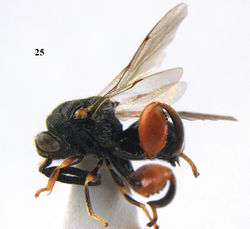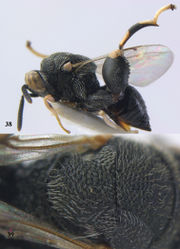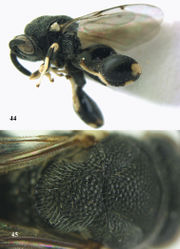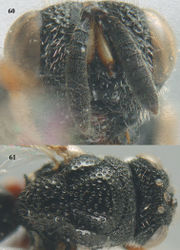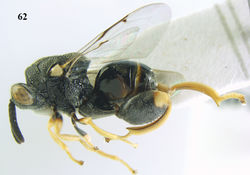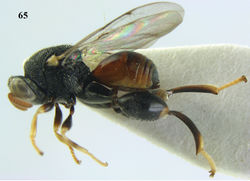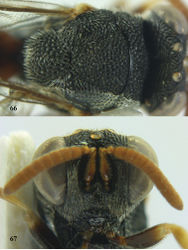| 1 | | | Postclypeus hardly or not differentiated from face and densely pubescent and groove absent (only smooth short anteclypeus visible); hind coxa with a trichoid zone on ventral side; [hind tibia completely yellow with base and ventral margin above black] | | | Brachymeria taiwana Habu |
| |
|
| – | | | Postclypeus distinctly differentiated from face and sparsely pubescent; hind coxa without a trichoid zone | | | 2 |
| |
|
| 2 | | | Inner side of hind femur with a small basal tubercle | | | 3 |
| |
|
| – | | | Inner side of hind femur without a basal tubercle | | | 4 |
| |
|
| 3 | | | Hind femur 1.8–2.1 times as long as wide; dorsal side of hind femur in lateral view dilated straightly from base to widest part, hence also straightly contracted towards apex so that dorsal side is weakly angulate; apical whitish patch on hind femur is generally limited on outer dorsal side, not extending to inner side | | | Brachymeria podagrica (Fabricius) |
| |
|
| – | | | Hind femur less than 1.7 times as long as wide; dorsal side of hind femur in lateral view not dilated, but rounded from base to apex; apical yellow patch extend to inner side | | | Brachymeria minuta (Linnaeus) |
| |
|
| 4 | | | Inner side of hind coxa of ♀ with a minute tooth ventrally | | | 5 |
| |
|
| – | | | Inner side of hind coxa of ♀ without minute tooth ventrally | | | 6 |
| |
|
| 5 | | | Hind tibia yellow with base and ventral margin black (Fig. 7); scape longer, reaching level of anterior ocellus (Fig. 46) | | | Brachymeria lasus (Walker) |
| |
|
| – | | | Hind tibia black with more or less yellow subbasal area and yellow apical area dorso-laterally (Fig. 33); scape shorter, remaining distinctly below level of anterior ocellus (Fig. 33) | | | Brachymeria coxodentata Joseph, Narendran & Joy |
| |
|
| 6 | | | Post-orbital carina absent | | | 7 |
| |
|
| – | | | Post-orbital carina present | | | 10 |
| |
|
| 7 | | | Hind tibia entirely yellow, except its dark ventral carina; T1 densely finely punctate and with satin sheen | | | Brachymeria carinata Joseph, Narendran & Joy |
| |
|
| – | | | Hind tibia bicoloured medially or largely black or reddish black basally; T1 smooth or largely so and strongly shiny | | | 8 |
| |
|
| 8 | | | Hind tibia yellow medially and only basally reddish black or black; apex of scutellum weakly emarginate | | | Brachymeria margaroniae Joseph, Narendran & Joy |
| |
|
| – | | | Hind tibia with blackish or brown band medially; apex of scutellum rounded | | | 9 |
| |
|
| 9 | | | Second hind tarsal segment distinctly longer than wide in dorsal view (Fig. 70); hind tibia with brownish band medially (Fig. 68) | | | Brachymeria shansiensis Habu |
| |
|
| – | | | Second hind tarsal segment hardly longer than wide in dorsal view (Fig. 38); hind tibia with blackish band medially (Fig. 38) | | | Brachymeria excarinata Gahan |
| |
|
| 10 | | | Pre-orbital carinae raised and converge to join with scrobal margin; [scutellum with a single median ridge or carina; hind tibia completely yellow] | | | Brachymeria scutellocarinata Joseph, Narendran & Joy |
| |
|
| – | | | Pre-orbital carina absent or if present and joining scrobal margin then not raised | | | 11 |
| |
|
| 11 | | | Hind tibia entirely yellow except ventral carina ventrally | | | 12 |
| |
|
| – | | | Hind tibia at least ventrally and part of inner side black or dark brown | | | 14 |
| |
|
| 12 | | | Setae dorsally on mesosoma and metasoma golden yellow and dense (Fig. 28); metasoma about as long as pronotum, mesoscutum and scutellum combined (Fig. 27) | | | Brachymeria aurea Girault |
| |
|
| – | | | Setae dorsally on mesosoma and metasoma silvery or greyish or pale yellow (Fig. 26); metasoma slightly shorter than pronotum, mesoscutum and scutellum combined (Fig. 29) | | | 13 |
| |
|
| 13 | | | Hind femur with large black medial patch and remainder yellow; posterior lamella of scutellum emarginated medio-posteriorly | | | Brachymeria megaspila (Cameron) |
| |
|
| – | | | Hind femur black except an ivory patch apically (Fig. 52); posterior lamella of scutellum evenly convex medio-posteriorly (Fig. 53) | | | Brachymeria marmonti (Girault) |
| |
|
| 14 | | | Hind femur red or brownish red with its apex yellow (rarely hind femur red with black patch medially in some extralimital specimens); apex of scutellum emarginate and with dense silvery pubescence; hind tibia yellow with its base and ventral side black or dark brown | | | Brachymeria bengalensis (Cameron) |
| |
|
| – | | | Hind femur black with its apex pale yellow; if hind femur red then without yellow or pale part apically; apex of scutellum without dense silvery pubescence and convex to distinctly emarginate medio-posteriorly; colour of hind tibia variable | | | 15 |
| |
|
| 15 | | | Metasoma with golden pubescence; remainder of body with white or grey pubescence; metasoma red but T1 medially and T2 to T5 anteriorly black; hind tibia black with weak brown subbasal spot and its apex yellow | | | Brachymeria semirusula sp. n. |
| |
|
| – | | | Metasoma with silvery or grey or white pubescence; metasoma completely black; colour of hind tibia variable | | | 16 |
| |
|
| 16 | | | Hind tibia yellow with its base and ventral side black or dark brown | | | 17 |
| |
|
| – | | | Hind tibia with different pattern, mostly black or black with its base and apex pale | | | 18 |
| |
|
| 17 | | | Metasoma globose or subglobose in lateral view (Fig. 36); clava more than twice as long as preceding segment | | | Brachymeria euploeae (Westwood) |
| |
|
| – | | | Metasoma acuminate posteriorly in lateral view (Fig. 42); clava shorter than twice length of preceding segment | | | Brachymeria jambolana Gahan |
| |
|
| 18 | | | Scutellum with a weak median carina or smooth ridge; [body black with inner side of fore and mid tibiae blackish brown and minute tan spot at apex of hind femur; hind tibia completely black; metasoma acuminate posteriorly and T1 faintly sculptured] | | | Brachymeria lugubris (Walker) |
| |
|
| – | | | Scutellum without median carina or smooth ridge | | | 19 |
| |
|
| 19 | | | Metasoma globose or subglobose in lateral view (Fig. 44); hind tibia black with a small subbasal pale spot and apically with yellow patch (Fig. 45) | | | Brachymeria kamijoi Habu |
| |
|
| – | | | Metasoma acuminate in lateral view (Figs 40, 48, 56); colour of hind tibia variable | | | 20 |
| |
|
| 20 | | | Hind femur red, without yellowish spot apically (Fig. 25); pre-orbital carina hardly indicated; hind tibia ferruginous or black with base and apex reddish brown | | | Brachymeria alternipes (Walker) |
| |
|
| – | | | Hind femur black or dark brown and with yellow spot apically (Figs 40, 48, 56); pre-orbital carina present; colour of hind tibia variable | | | 21 |
| |
|
| 21 | | | Apex of scutellum rounded (Figs 41, 50) | | | 22 |
| |
|
| – | | | Apex of scutellum weakly emarginate to distinctly incised medio-posteriorly (fig. 57) | | | 23 |
| |
|
| 22 | | | Scape slightly longer than combined length of F1 to F4; scrobe not reaching anterior ocellus (Fig. 49); area below scrobe with a distinct raised portion | | | Brachymeria longiscaposa Joseph, Narendran & Joy |
| |
|
| – | | | Scape about as long as combined length of F1 to F4; scrobe reaching anterior ocellusc; area below scrobe without a raised smooth part | | | Brachymeria hime Habu |
| |
|
| 23 | | | Base of hind tibia black; scape longer than combined length of F1 to F3 but not equal or exceeding combined length of F1 to F4; [scrobe not reaching anterior ocellus; pre- and post-orbital carinae present; apex of scutellum weakly emarginated] | | | Brachymeria olethria (Waterston) |
| |
|
| – | | | Base of hind tibia black, pale yellowish or yellowish brown; scape either shorter than combined length of F1 to F3 or at the most equal to combined length of F1 to F3 | | | 24 |
| |
|
| 24 | | | Scape shorter than combined length of F1 to F3; upper margin of clypeus smoothly curved and not angulate medially; clava as long as wide; apex of scutellum distinctly emarginate and bi-lobed (Fig. 57) | | | Brachymeria neowiebesina sp. n. |
| |
|
| – | | | Scape as long as combined length of F1 to F3; upper margin of clypeus angulate medially; clava slightly longer than 1.5 × its width; apex of scutellum weakly emarginate | | | Brachymeria wiebesina Joseph, Narendran & Joy |
| |

